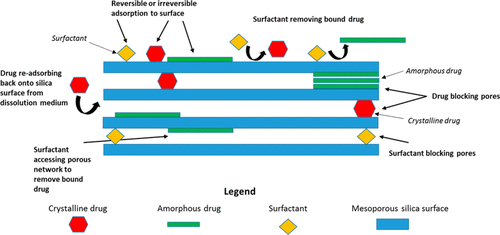当前位置:
X-MOL 学术
›
Mol. Pharmaceutics
›
论文详情
Our official English website, www.x-mol.net, welcomes your feedback! (Note: you will need to create a separate account there.)
Role of Drug Adsorption onto the Silica Surface in Drug Release from Mesoporous Silica Systems
Molecular Pharmaceutics ( IF 4.9 ) Pub Date : 2017-12-18 00:00:00 , DOI: 10.1021/acs.molpharmaceut.7b00778 Carol A. McCarthy 1 , Robert J. Ahern 1 , Ken J. Devine 2 , Abina M. Crean 1
Molecular Pharmaceutics ( IF 4.9 ) Pub Date : 2017-12-18 00:00:00 , DOI: 10.1021/acs.molpharmaceut.7b00778 Carol A. McCarthy 1 , Robert J. Ahern 1 , Ken J. Devine 2 , Abina M. Crean 1
Affiliation

|
Factors contributing to incomplete drug release from a number of mesoporous silica formulations are not well understood. This study aims to address this gap in knowledge by exploring the role of drug adsorption onto silica substrates during the drug release process in dissolution media. Adsorption isotherms were generated to understand drug adsorption behavior onto the silica surface. Two silica materials were selected (SBA-15 (mesoporous) and Aerosil 200 (nonporous)) to investigate the influence of porous architecture on the adsorption/dissolution processes. The ability of the dissolution medium to wet the silica surface, particularly the porous network, was investigated by the addition of a surfactant to the dissolution medium. The results demonstrated that a larger amount of drug was bound/m2 to the nonporous surface than to the mesoporous material. Adsorption isotherms proved useful in understanding drug adsorption/release behavior for the nonporous silica formulation. However, the quantity of drug remaining on the mesoporous silica surface after dissolution was significantly higher than the amount predicted using adsorption isotherm data. These results suggest that a fraction of loaded drug molecules were tightly bound to the silica surface or attached to sites which are inaccessible for the dissolution media. The presence of surfactant, sodium dodecyl sulfate, in the media enhanced drug release from the silica surface. This behavior can be attributed to both the improved wetting characteristics of the media and adsorption of the surfactant to the silica surface. The findings of this study reinforce the significance of the role that silica porous architecture plays in the dissolution process and indicates that accessible surface area is an important parameter to consider for mesoporous systems in relation to drug release.
中文翻译:

吸附在二氧化硅表面上的药物在介孔二氧化硅系统释放药物中的作用
导致许多介孔二氧化硅制剂中药物释放不完全的因素尚不十分清楚。这项研究旨在通过探索药物在溶出介质中释放过程中吸附在硅胶基质上的作用来解决这一知识差距。产生吸附等温线以了解药物在二氧化硅表面上的吸附行为。选择两种二氧化硅材料(SBA-15(中孔)和Aerosil 200(无孔))来研究多孔结构对吸附/溶解过程的影响。通过向溶解介质中添加表面活性剂来研究溶解介质润湿二氧化硅表面,特别是多孔网络的能力。结果表明,每m 2结合的药物量更多到无孔表面比到中孔材料。吸附等温线被证明有助于理解无孔二氧化硅制剂的药物吸附/释放行为。但是,溶解后保留在中孔二氧化硅表面上的药物数量明显高于使用吸附等温线数据预测的数量。这些结果表明,一部分负载的药物分子紧密结合至二氧化硅表面或附着于溶解介质难以接近的部位。介质中表面活性剂十二烷基硫酸钠的存在增强了药物从二氧化硅表面的释放。该行为可归因于介质的改善的润湿特性和表面活性剂对二氧化硅表面的吸附。
更新日期:2017-12-18
中文翻译:

吸附在二氧化硅表面上的药物在介孔二氧化硅系统释放药物中的作用
导致许多介孔二氧化硅制剂中药物释放不完全的因素尚不十分清楚。这项研究旨在通过探索药物在溶出介质中释放过程中吸附在硅胶基质上的作用来解决这一知识差距。产生吸附等温线以了解药物在二氧化硅表面上的吸附行为。选择两种二氧化硅材料(SBA-15(中孔)和Aerosil 200(无孔))来研究多孔结构对吸附/溶解过程的影响。通过向溶解介质中添加表面活性剂来研究溶解介质润湿二氧化硅表面,特别是多孔网络的能力。结果表明,每m 2结合的药物量更多到无孔表面比到中孔材料。吸附等温线被证明有助于理解无孔二氧化硅制剂的药物吸附/释放行为。但是,溶解后保留在中孔二氧化硅表面上的药物数量明显高于使用吸附等温线数据预测的数量。这些结果表明,一部分负载的药物分子紧密结合至二氧化硅表面或附着于溶解介质难以接近的部位。介质中表面活性剂十二烷基硫酸钠的存在增强了药物从二氧化硅表面的释放。该行为可归因于介质的改善的润湿特性和表面活性剂对二氧化硅表面的吸附。



























 京公网安备 11010802027423号
京公网安备 11010802027423号